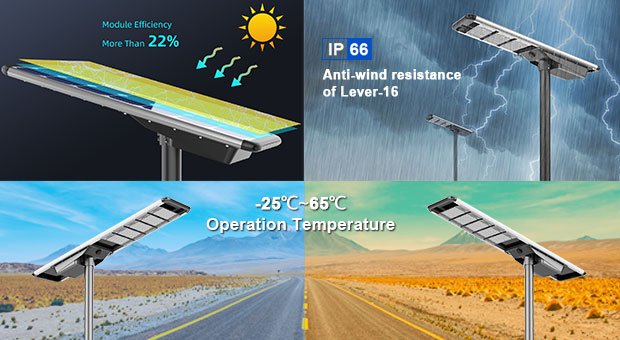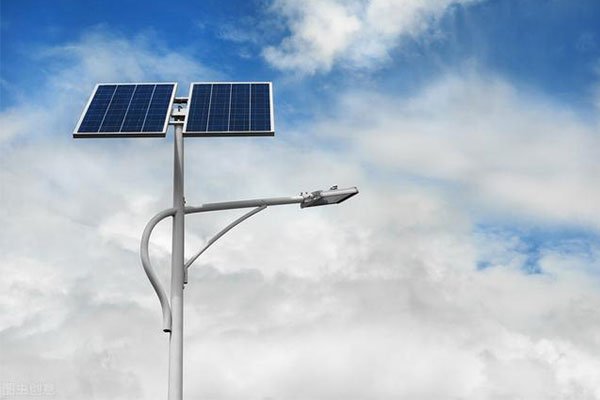Many people worry that integrated solar street lights1 won’t work in rainy or snowy conditions. Reduced sunlight might seem like a problem, but is it really?
The answer is yes! Integrated solar street lights are designed to function even in bad weather. With high-capacity batteries2, efficient solar panels, and smart energy management3, they continue to provide lighting during cloudy, rainy, or snowy days.
Weather conditions impact solar energy generation, but with the right technology, integrated solar street lights1 can remain reliable. Let’s explore how they perform in different situations.
How Do Solar Street Lights Function on Rainy Days?
Many assume that solar panels stop working on cloudy or rainy days. However, modern panels still generate energy, even in diffused sunlight.
How Solar Panels Capture Energy in the Rain
Solar panels don’t need direct sunlight; they can absorb energy from indirect and scattered light. Even on rainy days, they continue to generate electricity, although at a lower efficiency.
Key Features That Improve Performance in Rainy Conditions
- High-Efficiency Panels – Monocrystalline panels work better in low-light conditions.
- Smart Battery Storage – Advanced lithium batteries store excess energy from sunny days to power lights on cloudy days.
- Energy-Saving Technology – Intelligent controllers adjust brightness to extend battery life during extended rainy periods.
Can Integrated Solar Street Lights Survive in Snowy Weather?

Snow accumulation can block sunlight, but properly designed solar street lights can still operate efficiently.
Challenges of Snowy Weather
- Snow Cover on Panels – Blocks sunlight, reducing energy generation.
- Cold Temperatures – Affect battery performance and charging efficiency.
- Shorter Daylight Hours – Less sunlight means less energy stored.
Solutions for Optimal Performance in Snow
- Tilted Panel Design – Angled panels allow snow to slide off instead of accumulating.
- Self-Heating Batteries – Some lithium batteries have heating functions to prevent freezing.
- Adaptive Dimming – Reduces brightness on low-energy days to extend operational hours.
How Long Can Solar Street Lights Work Without Sunlight?
Many integrated solar street lights1 come with a backup energy supply, allowing them to work for multiple days without sunlight.
Battery Backup and Storage Capacity
- Standard solar street lights – 2-3 days of battery backup.
- High-capacity models – Up to 5-7 days of operation in extreme weather.
How to Maximize Battery Performance
- Use High-Quality Lithium Batteries – Longer lifespan and better energy storage.
- Optimize Panel Positioning – Ensures maximum sunlight absorption year-round.
- Choose Models with Smart Controllers – Adjust brightness automatically to conserve energy.
Do Solar Street Lights Get Damaged in Extreme Weather?

Durability depends on build quality. High-quality integrated solar street lights1 withstand harsh conditions, including heavy rain, snow, and strong winds.
Features That Enhance Weather Resistance
| Feature | Benefit |
|---|---|
| Waterproof Enclosure | Protects electronics from rain and moisture. |
| Corrosion-Resistant Materials | Prevents rust and wear over time. |
| Wind-Resistant Design | Strong poles and secure mounting prevent damage. |
| Temperature-Controlled Batteries | Ensures optimal performance in extreme cold or heat. |
Conclusion
Integrated solar street lights are built to handle rainy and snowy conditions. With high-efficiency panels, smart energy storage, and durable materials, they continue to operate even in bad weather. Choosing high-quality models with intelligent energy management ensures reliable lighting throughout the year, regardless of climate challenges.
Explore how integrated solar street lights are designed to perform efficiently in various weather conditions, ensuring reliable lighting. ↩ ↩ ↩ ↩
Learn about the role of high-capacity batteries in maintaining solar street light functionality during adverse weather. ↩
Discover how smart energy management optimizes solar street light performance, especially in challenging weather conditions. ↩







